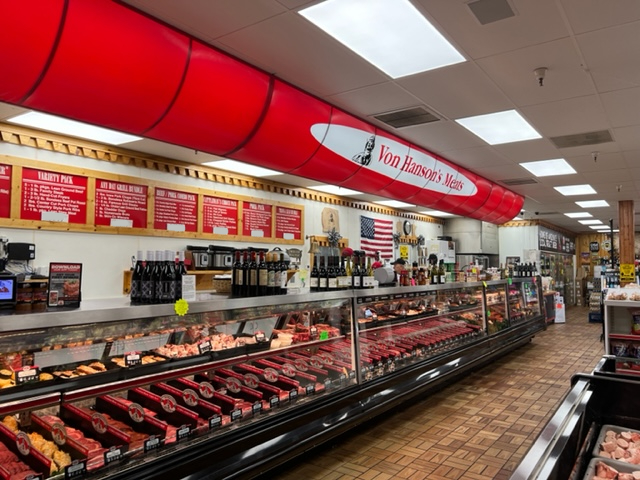What Makes Bagley Farms Meat Market Edwardsville IL Stand Out for Meat Lovers
What Makes Bagley Farms Meat Market Edwardsville IL Stand Out for Meat Lovers
Blog Article
Discover the Finest Selection of Cuts From Neighborhood Meat Market
In a period where the beginnings of our food are extra substantial than ever before, checking out the finest option of cuts from your regional meat market uses a compelling story of high quality and honesty. These markets not just guarantee unparalleled quality and preference however likewise offer insights into the subtleties of various primitive and sub-primal cuts. As we discover the benefits of reduced supply chains and seasonal options, there lies a deeper story regarding sustaining sustainable practices and enriching your cooking collection. What tricks do these local purveyors hold that could transform your next meal right into a premium experience?
Advantages of Neighborhood Meat Markets
Local meat markets offer various benefits that are ending up being increasingly significant in today's food landscape. Since the supply chain is shorter, local meat does not sustain extensive transport times, protecting its freshness and dietary worth.
In addition, neighborhood meat markets often support sustainable farming methods. Several neighborhood producers involve in eco-friendly and ethical farming techniques, which add to the well-being of pets and the conservation of all-natural resources. By choosing to buy from these markets, consumers can play a duty in advertising sustainable agriculture and lowering their carbon footprint.
Furthermore, local meat markets add to the financial vitality of neighborhoods. By sustaining neighborhood manufacturers, consumers assist receive local business and foster financial development within their region. This economic support can lead to task creation and help maintain the one-of-a-kind character of neighborhood communities.
Understanding Different Meat Cuts
A fundamental element of making enlightened buying choices at regional meat markets is understanding the various cuts of meat offered. Primarily, meat is classified into primal, sub-primal, and retail cuts.
For instance, from the beef primitive cut, the loin, one can obtain sub-primal cuts like tenderloin, bring about retail choices such as filet mignon. The rib primal cut includes sub-primal ribs, producing retail choices like ribeye steaks. Understanding these distinctions help in picking cuts that line up with cooking requirements and individual choices
Moreover, cuts differ in tenderness and fat material, influencing their excellent food preparation techniques. Harder cuts like brisket gain from slow food preparation, while tender cuts like sirloin are suited for grilling. By comprehending these nuances, customers can improve their cooking experiences and enhance their meat purchases.

Specialist Tips for Deciding On Meat
Picking the excellent cut of meat calls for not only understanding of the different choices available but also a keen understanding of high quality signs that professionals use to make their choices. First of all, focus must be positioned on the shade of the meat. Vibrant, abundant shades normally mirror quality, while dull or grayish tones may indicate aging or inappropriate storage. Next off, think about marbling, the great streaks of fat within the muscle mass. A well-marbled cut typically assures improved taste and inflammation, as the fat thaws throughout cooking, enhancing the meat's appearance and preference.
Another essential element is the meat's texture. Specialist recommendations likewise entails checking out the packaging, if suitable.

Last but not least, comprehending the credibility and sourcing methods of your regional meat service provider can use understandings into the high quality and ethical standards of the meat. Involving with well-informed butchers can offer useful recommendations tailored to particular culinary needs, making certain a remarkable dining experience.
Best Seasonal Choices

Selecting seasonal cuts not only makes sure freshness yet additionally lines up with the peak high quality of various meats. Pork, traditionally healed and protected in the colder months, supplies a rich range of cuts like ham and bacon during winter, when pigs are butchered after being plumped on fall harvests. Fowl, on the various other hand, is usually at its ideal during late spring and early summer, when hens have grown on a diet regimen of fresh grains and greens.
Sustaining Sustainable Practices
Embracing sustainable practices in meat production is necessary for advertising environmental health and making sure the longevity of find out here now local ecological communities. In the context of local meat markets, sustainability entails a dedication to moral farming methods, lowering carbon impacts, and supporting biodiversity. By focusing on these practices, producers not just enhance the top quality of their offerings but additionally add favorably to their communities and the planet.
Regional meat markets play a pivotal duty in fostering sustainable agriculture by sourcing items from farms that apply green techniques. These may include rotational grazing, natural feed, and integrated insect management, which jointly minimize environmental effect and advertise animal welfare. By picking to support such markets, consumers can directly influence the need for sustainably elevated meat, encouraging even more manufacturers to embrace these practices.
Moreover, sustainable methods in meat manufacturing can substantially mitigate the market's ecological impact. Supporting sustainable practices not only benefits the setting however likewise aligns with a wider dedication to accountable consumption and production.
Conclusion
Local meat markets provide unrivaled advantages in regards to top quality, quality, and sustainability. By providing a diverse series of primal and sub-primal cuts, these markets accommodate different cooking preferences while guaranteeing openness description in sourcing. Seasonal options, such as springtime lamb and autumn beef, improve the cooking experience with special tastes and inflammation. Sustaining neighborhood meat markets not only advertises lasting farming practices but also adds to a more educated and gratifying culinary trip.
Report this page